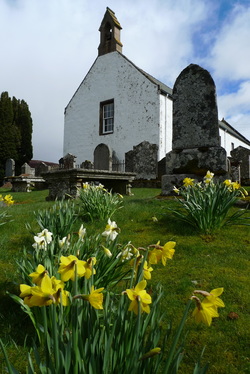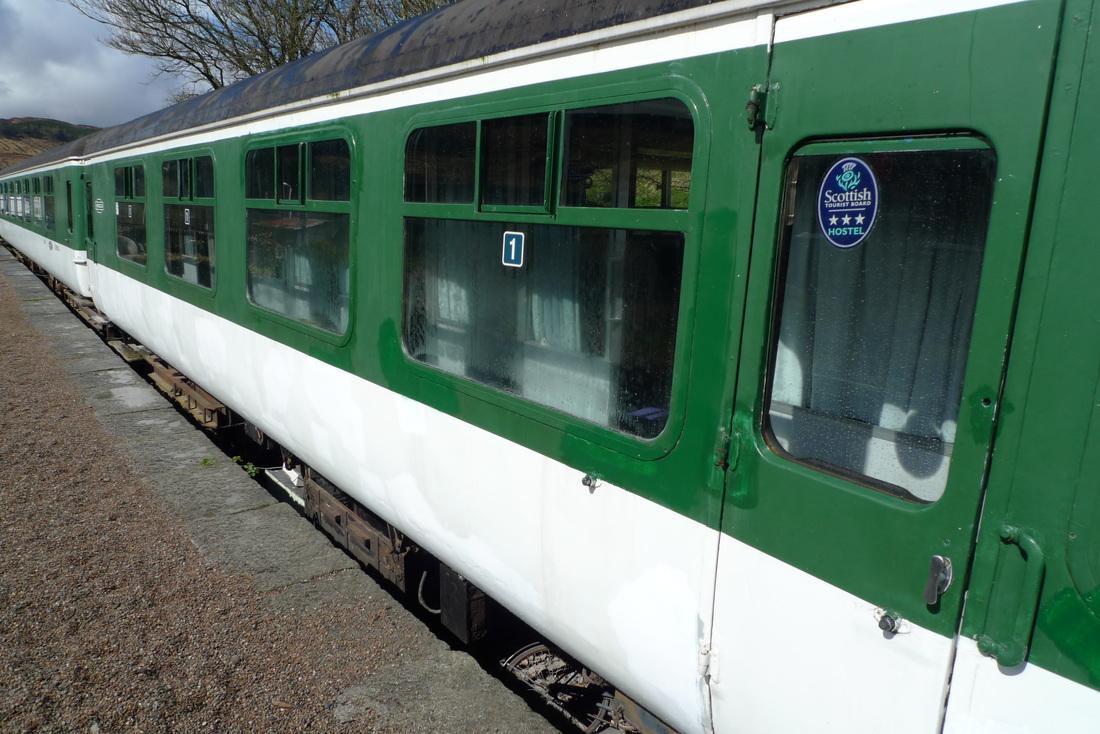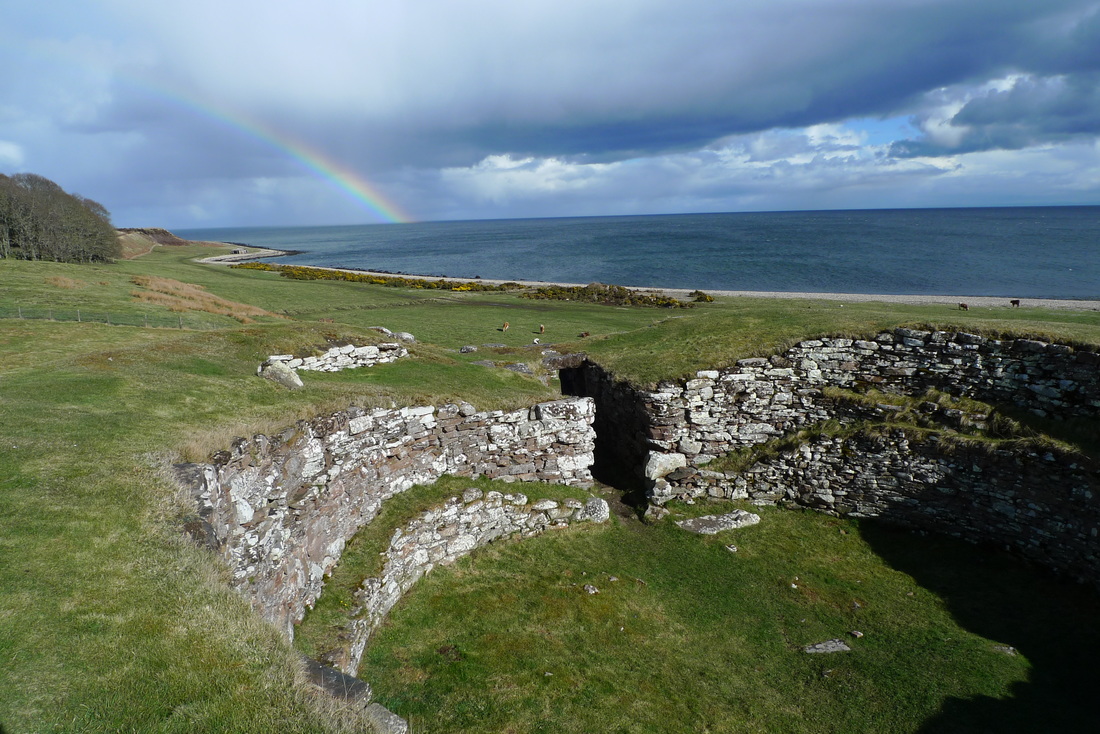This is the way train travel should be. I sunk into the seat- it was not hard, but bouncy. It had a fold down armrest, upholstered, not made of plastic. I was in a compartment with a sliding door that gave privacy, not in an open coach where I could hear the pointless "I'm on the train" mobile phone conversations. I sat back with my glass of Glenmorangie and turned to watch the world go by, except it wasn't going anywhere. I was sitting in a relic, a 1969 British Railways coach, retired to a siding, behind Rogart station, 50 miles north of Inverness.
British people tend to get nostalgic about railways, believing it was better back in the day. When you have the opportunity to spend some time in an old carriage, like this one, you begin to understand what they are going on about- it seems roomier, sturdier and more comfortable than the trains of today. I was staying the night in this carriage, part of a unique hostel called Sleeperzzz (yes, with three Zs). It has been ingeniously converted into accommodation with bunk beds, communal kitchen and dining area. Much of the original character of the train is intact with luggage racks, emergency pull cords and intercity route maps in the toilets.
British people tend to get nostalgic about railways, believing it was better back in the day. When you have the opportunity to spend some time in an old carriage, like this one, you begin to understand what they are going on about- it seems roomier, sturdier and more comfortable than the trains of today. I was staying the night in this carriage, part of a unique hostel called Sleeperzzz (yes, with three Zs). It has been ingeniously converted into accommodation with bunk beds, communal kitchen and dining area. Much of the original character of the train is intact with luggage racks, emergency pull cords and intercity route maps in the toilets.
 Saint Callan's, Rogart
Saint Callan's, Rogart
"This carriage did the Edinburgh to Plymouth run," Frank Roach, who owns Sleeperzzzz, presented me with an old-style train ticket printed with 'first class sleeping car berth'. He came round to collect the acommodation fee, rather like a train conductor, and punched a hole in the ticket. I received a 10 per cent discount because I arrived by bicycle and train.
I was sharing my carriage with a group of workmen. Frank pointed to the hill on the other side of the tracks, "they are replanting that hill. Not easy work in weather like this." The rain had been heavy and hiking, digging and lifting would be tough. The treeplanters kept to themselves, watching a film on a laptop and going to bed early. In the morning I found them in the kitchen cooking spaghetti bolognaise for their breakfast.
When Frank discovered that I had begun my journey at Conon Bridge, the newest station on this line, he said, "I was responsible for getting that reoponed. It took six years to get it reopened. It's what I do- support rail infrastructure in the highlands" Frank is also the Partnership Manager of Highlands and Islands Regional Transport Partnership which works with councils, rail companies and others to improve transport services. He urged me to urge my family to make use of Conon Bridge, "Make sure they use it, or we could lose it."
Frank's work has led to positive change on the Far North Line, from reopened stations to improved timetables. It is my favourite line in Scotland because of the many isolated stations that access wilderness roads where you can be on your own for miles and miles. This is why I came to Rogart. I had seen it on my well-thumbed map, a twisting minor road heading into Strath Brora, far from traffic and crowds of people. I was dreaming of a hidden gem, some sort of cyclists paradise that nobody else knew about. This is exactly what I found.
It began with a tough climb out of Rogart, forcing me into the lowest gears. It is a twisty road, single-track with passing places and little used by motor vehicles. I crossed over a short stone arched-bridge and peered below to watch the water rushing by. Through spindly tree branches, caked with lichen I could see dark blue water where the river is still and white foam and swirls where it falls over rocks. I love that sound, it makes me feel calm. I lingered to listen and watch.
Leaping lambs
I arrived at Saint Callan's church, clumps of daffodils bringing yellow joy to the grounds. The building iis white, pealing in places, its tall sash n' case windows identifying it as late eighteenth-cetury. A sign announes that services are held on the 2nd and 4th Saturdays of the month. A path snakes between headstones blotched with lichen. I tried the door, but it was locked.
The landscape is bumpy with green fields portioned by dry-stone walls. Chickens came running towards me from the drive of a cottage with blue window frames. A farmer with a Santa-style beard passed me in a tractor. Four geese eyed me up and I was thankful they were behind a fence- they looked fierce.
The lambs were cuddlier and there were plenty of them leaping about on the road. I slowed down to give them a chance to escape. I also encountered a calf and its mother running away from me. Contending with the vagaries of livestock was all part of the Strath Brora experience.
An abundance of water features also characterises this land. Rushing rivers, waterfalls and trickling streams were the soundtrack of this ride. There were many stone arched bridges to cross where the watery sounds entered my headspace for the few seconds that I took to pass over the bridge.
There was a particulalry barren and exposed section of the road that took me alongside the River Brora. It was down below me, twisting among moorland, the occassional tree on its banks, sparkling like a silver necklace when the sun flashed it. Behind the river there is a hillside almost completely brown with Heather. Landscapes like this make me feel vulnerable because of their vastness and lack of shelter in bad weather, but they also impress me because nature has made them too harsh for humans to consider settling here.
There is great variety in Strath Brora and so the road soon leaves behind this rough section and enters a softer land of grass and pine forest. I passed signs pointing to settlements that didn't even featue on my map, places considered too insignifiacnt to the outside world, but part of the everyday routine of locals- Balclaggan, Achnaggarin, Scibercross. At the point where the Black Water and the River Brora met they were flooding onto the road. I could not tell how deep it was and cautiously peddled through. A nice little challenge that added to the sense of adventure that this journey was bringing. I was loving every minute of this cycle because of the wildness of it, the solitude of it and the surprises.
Water world
The next treat was reaching Loch Brora. This is not one of Scotland's famous lochs, it is not a Loch Lommond or a Loch Ness, so there is no development. There is no busy road running alongside it, no hotels or hoards of tourists in the summer. Do an Internet search and you will find next to no information apart from references to fishing. On the opposite shore there is a mass of hillside, one side of it with a sheer rockface. I parked my bike against a "passing place" sign and walked across clumpy grass to reach a pebble beach. I sat on the verge and had my avodcado and pinenut sandwich and wondered if anybody had ever eaten this exact type of sandwich on this exact spot. Probably not. This is proper get-away-from-it-all Scotland where few people have visited and you will have it all to yourself.
I was sharing my carriage with a group of workmen. Frank pointed to the hill on the other side of the tracks, "they are replanting that hill. Not easy work in weather like this." The rain had been heavy and hiking, digging and lifting would be tough. The treeplanters kept to themselves, watching a film on a laptop and going to bed early. In the morning I found them in the kitchen cooking spaghetti bolognaise for their breakfast.
When Frank discovered that I had begun my journey at Conon Bridge, the newest station on this line, he said, "I was responsible for getting that reoponed. It took six years to get it reopened. It's what I do- support rail infrastructure in the highlands" Frank is also the Partnership Manager of Highlands and Islands Regional Transport Partnership which works with councils, rail companies and others to improve transport services. He urged me to urge my family to make use of Conon Bridge, "Make sure they use it, or we could lose it."
Frank's work has led to positive change on the Far North Line, from reopened stations to improved timetables. It is my favourite line in Scotland because of the many isolated stations that access wilderness roads where you can be on your own for miles and miles. This is why I came to Rogart. I had seen it on my well-thumbed map, a twisting minor road heading into Strath Brora, far from traffic and crowds of people. I was dreaming of a hidden gem, some sort of cyclists paradise that nobody else knew about. This is exactly what I found.
It began with a tough climb out of Rogart, forcing me into the lowest gears. It is a twisty road, single-track with passing places and little used by motor vehicles. I crossed over a short stone arched-bridge and peered below to watch the water rushing by. Through spindly tree branches, caked with lichen I could see dark blue water where the river is still and white foam and swirls where it falls over rocks. I love that sound, it makes me feel calm. I lingered to listen and watch.
Leaping lambs
I arrived at Saint Callan's church, clumps of daffodils bringing yellow joy to the grounds. The building iis white, pealing in places, its tall sash n' case windows identifying it as late eighteenth-cetury. A sign announes that services are held on the 2nd and 4th Saturdays of the month. A path snakes between headstones blotched with lichen. I tried the door, but it was locked.
The landscape is bumpy with green fields portioned by dry-stone walls. Chickens came running towards me from the drive of a cottage with blue window frames. A farmer with a Santa-style beard passed me in a tractor. Four geese eyed me up and I was thankful they were behind a fence- they looked fierce.
The lambs were cuddlier and there were plenty of them leaping about on the road. I slowed down to give them a chance to escape. I also encountered a calf and its mother running away from me. Contending with the vagaries of livestock was all part of the Strath Brora experience.
An abundance of water features also characterises this land. Rushing rivers, waterfalls and trickling streams were the soundtrack of this ride. There were many stone arched bridges to cross where the watery sounds entered my headspace for the few seconds that I took to pass over the bridge.
There was a particulalry barren and exposed section of the road that took me alongside the River Brora. It was down below me, twisting among moorland, the occassional tree on its banks, sparkling like a silver necklace when the sun flashed it. Behind the river there is a hillside almost completely brown with Heather. Landscapes like this make me feel vulnerable because of their vastness and lack of shelter in bad weather, but they also impress me because nature has made them too harsh for humans to consider settling here.
There is great variety in Strath Brora and so the road soon leaves behind this rough section and enters a softer land of grass and pine forest. I passed signs pointing to settlements that didn't even featue on my map, places considered too insignifiacnt to the outside world, but part of the everyday routine of locals- Balclaggan, Achnaggarin, Scibercross. At the point where the Black Water and the River Brora met they were flooding onto the road. I could not tell how deep it was and cautiously peddled through. A nice little challenge that added to the sense of adventure that this journey was bringing. I was loving every minute of this cycle because of the wildness of it, the solitude of it and the surprises.
Water world
The next treat was reaching Loch Brora. This is not one of Scotland's famous lochs, it is not a Loch Lommond or a Loch Ness, so there is no development. There is no busy road running alongside it, no hotels or hoards of tourists in the summer. Do an Internet search and you will find next to no information apart from references to fishing. On the opposite shore there is a mass of hillside, one side of it with a sheer rockface. I parked my bike against a "passing place" sign and walked across clumpy grass to reach a pebble beach. I sat on the verge and had my avodcado and pinenut sandwich and wondered if anybody had ever eaten this exact type of sandwich on this exact spot. Probably not. This is proper get-away-from-it-all Scotland where few people have visited and you will have it all to yourself.
The loch is about 3 miles long and when I reached the end I took the right turn to Doll. Then another little adventure; a ford crossing. The road dipped down to the river, which was fast flowing, and vehicles have to drive through it to reach the other side of the road. I had never come across a ford crossing until that momment and something I associated with much wilder places like Siberia or the Amazon, but then Strath Brora is a wild place. I rode down to the water's edge, but it looked too deep and fast for a bicycle. Luckily there is a footbridge, otherwise I don't think I would have made it to the other side.
This marked the end of Strath Brora. I was deposited onto the A9, a notoriously busy road, but it is impossible to do a circular route without using it. On this occassion it was not too bad, although I was passed by two articulated lorries creating a gust of wind that caused me to wobble.
This marked the end of Strath Brora. I was deposited onto the A9, a notoriously busy road, but it is impossible to do a circular route without using it. On this occassion it was not too bad, although I was passed by two articulated lorries creating a gust of wind that caused me to wobble.
Alongside the A9 there is a ruin of an Iron Age dwelling called Cam Liath Broch. Brochs are unique to Scotland and there are more of them in this part of the country than any other region. They were built as tall circular stone towers, possibly as secure family homes. The entrance to this one was being guarded by a cow and she was determined to protect the lush grass. She stared at me as I moved in cautiously. I got closer and with a shake of her head she reluctantly moved off to join the rest of the heard down on the beach.
I had to duck down to proceed through the doorway and into the base of the structure. This broch has a staircase that would have spiralled to the top of the structure, but now ends at a rim from which to enjoy views of the North Sea. Today there was a rainbow, the inveitable and happy result of today's mix of rain and sunshine. The colours were particulalry bold at the point where it looked like it was gushing out of the sea.
What always impresses me the most about brochs is the intricacy of the stonework. No masonry was used and many diffrent sizes and shapes of stones were perfectly laid together to interlock them and make the structure solid. It was like Iron Age lego. The high quality of broch construction reminded me of my British Railways coach. They certainly built things to last back in the day.
Tonight I slid the door closed on my compartment, drew the curtains and put on the original under-seat heating. It was a cosy place to enjoy a whisky and write up my notes. This is the way train travel should be.
PartTwo of this journey: Dunrobin Castle
Getting there
The train from Inverness to Rogart takes around 2 hours. Services on this route are infrequent with four trains per day. Rogart is a request stop which means the train will not stop unless you advise the guard in advance that you wish to get off.
Cycling distances and terrain
This circular route is a total of 48km. It is 28km from Rogart station to Doll through Strath Brora and 20km from Doll back to Rogart via the A9. The Strath Brora road is single-track with passing places. There is hardly any traffic and you will have much of it to yourself, so this really is perfect cycling. There are some uphills with the climb out of Rogart being the steepest.
There is a 13km stretch on the A9 and this is a busy road with fast moving traffic. Some parts of the road are nice and wide, so there is plenty of space for safe overtaking, but some parts are narrower. If you are nervous in traffic I would not recommend using the A9, so you may wish to go back the way you came which is longer, but no bad thing considering how beautiful Strath Brora is. The traffic on the A9 can be lighter at certain times of the day such as early evening, so you could try to time your ride on this basis.
Things to see and do
Carn Liath Broch is free to visit. There are no facilities, just an information panel. Nearby to the broch is Dunrobin Castle which has paid admission.
Where to stay and eat
Spend the night on a bunkbed in old railway carriages at Sleeperzz, behind Rogart station. The carriages are named after single malt whiskies. You can also stay in a 1930s fairground showman's wagon or a Bedford bus. This is classed as hostel accommodation so the prices are very reasonable. There is a review of Sleeperzzz on the Indenpendent website.
You will not find any tearooms or cafes in Strath Brora, which is part of the attraction of the area. The Pittentrail Inn is a two-minute walk from Sleeperzz and serves bar meals, but it is worth checking in advance if they will be open during your visit. Golspie is the place to go for supplies if you are going to use the kitchen facilities at Sleeperzzz. The town has a good selection of shops, cafes, pubs and restaurants.
The train from Inverness to Rogart takes around 2 hours. Services on this route are infrequent with four trains per day. Rogart is a request stop which means the train will not stop unless you advise the guard in advance that you wish to get off.
Cycling distances and terrain
This circular route is a total of 48km. It is 28km from Rogart station to Doll through Strath Brora and 20km from Doll back to Rogart via the A9. The Strath Brora road is single-track with passing places. There is hardly any traffic and you will have much of it to yourself, so this really is perfect cycling. There are some uphills with the climb out of Rogart being the steepest.
There is a 13km stretch on the A9 and this is a busy road with fast moving traffic. Some parts of the road are nice and wide, so there is plenty of space for safe overtaking, but some parts are narrower. If you are nervous in traffic I would not recommend using the A9, so you may wish to go back the way you came which is longer, but no bad thing considering how beautiful Strath Brora is. The traffic on the A9 can be lighter at certain times of the day such as early evening, so you could try to time your ride on this basis.
Things to see and do
Carn Liath Broch is free to visit. There are no facilities, just an information panel. Nearby to the broch is Dunrobin Castle which has paid admission.
Where to stay and eat
Spend the night on a bunkbed in old railway carriages at Sleeperzz, behind Rogart station. The carriages are named after single malt whiskies. You can also stay in a 1930s fairground showman's wagon or a Bedford bus. This is classed as hostel accommodation so the prices are very reasonable. There is a review of Sleeperzzz on the Indenpendent website.
You will not find any tearooms or cafes in Strath Brora, which is part of the attraction of the area. The Pittentrail Inn is a two-minute walk from Sleeperzz and serves bar meals, but it is worth checking in advance if they will be open during your visit. Golspie is the place to go for supplies if you are going to use the kitchen facilities at Sleeperzzz. The town has a good selection of shops, cafes, pubs and restaurants.
|
|
|


